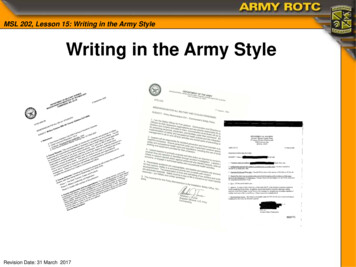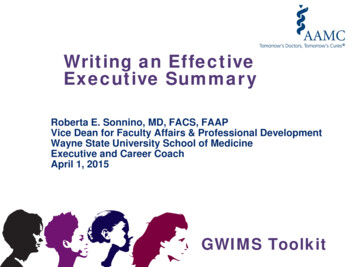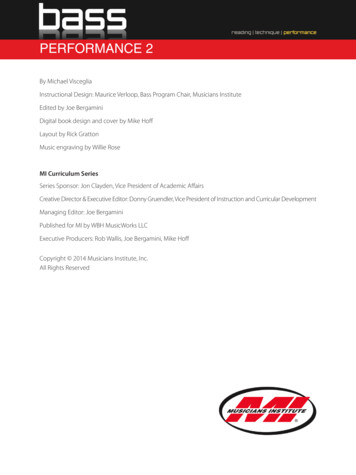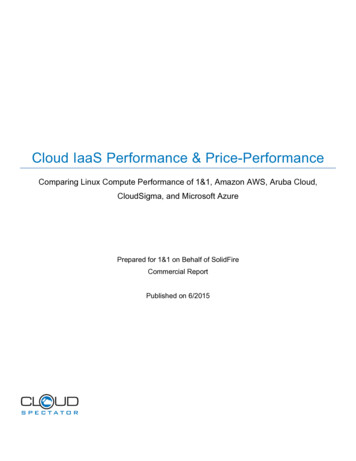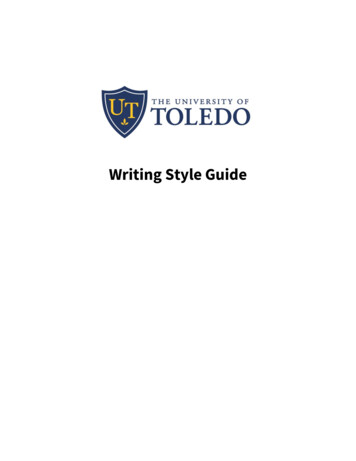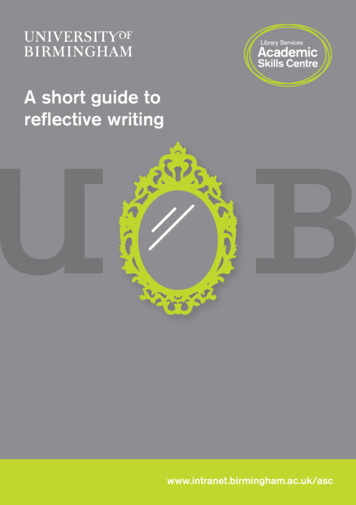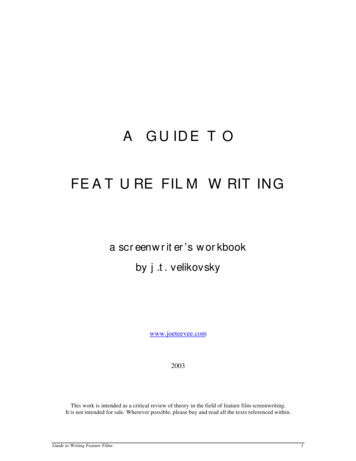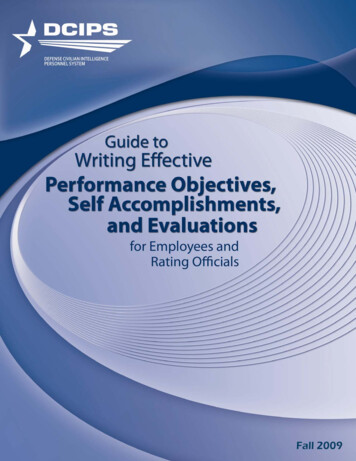
Transcription
Guide to Writing Effective Performance Objectives, Self Accomplishments and EvaluationsTABLE OF CONTENTSBackground & Purpose.1How to Use This Guide .2Writing Effective Performance Objectives.3Six Steps to Writing Effective Performance Objectives.31. Understand the Purpose of Performance Objectives .32. Compile Your Resources .43. Determine the Most Important Aspects of the Job .54. Work Activities End Results .55. End Results Objectives: Make Your “End Result” SMART .56. Review Your Performance Objectives using the Checklist for Writing Effective .Performance Objectives .10Performance Objective Checklist & Examples.11Performance Objective Examples: Applying the Checklist .12Work Level Descriptions .16Performance Objective Examples: Applying Work Level Descriptions.17Common Challenges & Potential Solutions.19Writing Objectives for a Job that Changes .19Writing Objectives for Long-term Goals.20Writing Objectives for Activities Not Easily Measured.21Writing Objectives at the Appropriate Level of Difficulty.22Writing Clear Objectives.22Writing Objectives that Relate to Higher-level Goals/Objectives.23Using Mandated, but Poorly Written Performance Objectives.24Addressing Performance Elements.25Writing Self-Accomplishment Reports and Evaluations .27Six Tips for Writing Effective Self Accomplishment Reports .28Models for Writing Self Accomplishment Reports.29The ORCA Approach.29The SCRAM Approach .30Examples for Applying the Accomplishment Evaluation Criteria .33Using the DCIPS Performance Appraisal Application .37DCIPS PAA Facts and Tips to Consider .37Accessing Resources.38Resources.38Training.38Fall 2009
Guide to Writing Effective Performance Objectives, Self Accomplishments and EvaluationsBackground & PurposeUnder the Defense Civilian Intelligence Personnel System (DCIPS), supervisor/manager-employeecollaboration to develop meaningful, well written, and effective performance objectives and selfaccomplishment reports and evaluations is important to ensuring that employees: Understand what is expected of them at the beginning of the performance cycle Are focused on work that aligns with and supports organizational goals and priorities Are appropriately rated and recognized for their contributionsThe Guide to Writing Effective Performance Objectives, Self Accomplishments andEvaluations is written to provide you with information and examples on how to successfullyaccomplish these requirements. While the information is written for employees, it also applies tomanagers and supervisors (known as rating officials and reviewing officials during the performanceprocess). Under DCIPS: At the beginning of the rating cycle or when employees move to an organization, ratingofficials are required to establish employee performance plans that include performanceobjectives and the required performance elements. It is a best practice for employees to beinvolved in developing their performance objectives so that there is a shared understandingof expectations from the beginning. Performance plans, including performance objectivesare approved once reviewing officials have reviewed them and the plans are communicatedto employees. Throughout the performance cycle, employees and rating officials engage in performancerelated conversations and review performance plans. This ongoing dialogue ensures thatemployees remain focused on organizational priorities. Midway through the performance cycle, employees and rating officials complete a requiredmidpoint performance review. The midpoint performance review is an opportunity forperformance objectives to be adjusted if expectations and priorities have changed. It is abest practice for performance objectives not to change after the midpoint performancereview so that employees have sufficient time to demonstrate their abilities to meetperformance expectations. At the end of the cycle, employees complete self accomplishment reports that documenttheir accomplishments as they relate to performance objectives and performance elements.After reviewing self accomplishment reports, rating officials complete their evaluations andratings and submit them to reviewing officials for approval. Final ratings are used todetermine performance-based payouts that are given in the form of base salary increases,bonuses, or combinations of both.This guide is written at the enterprise-level. As such, employees, rating officials, and reviewingofficials should ensure that they are complying with any agency or component-specific guidance.1Fall 2009
Guide to Writing Effective Performance Objectives, Self Accomplishments and EvaluationsHow to Use This GuideThis guide supplements DCIPS training on writing effective performance objectives, selfaccomplishment reports, and evaluations and provides step-by-step guidelines for employees andrating officials on writing and evaluating the quality and completeness of performance objectives andperformance elements.This guide contains the following sections:2 Writing Effective Performance Objectives describes the SMART model and offers checklists andexamples. Writing Effective Self-Accomplishment Reports and Evaluations describes two models and offersexamples. Using the DCIPS Performance Appraisal Application provides general information on using thetool. Accessing Resources identifies the various resources, training, and tools available.Fall 2009
Guide to Writing Effective Performance Objectives, Self Accomplishments and EvaluationsWriting Effective Performance ObjectivesWriting effective performance objectives starts with understanding what performance objectives areand how the align with and support your organization’s goals, objectives, and priorities. It starts byfollowing six steps.Six Steps to Writing Effective Performance Objectives1. Understand the Purpose of Performance ObjectivesA performance objective is a specific end result that contributes to the success of the unit ororganization and that an employee is expected to accomplish or produce.Performance objectives provide focus to an employee’s work to ensure that his or her actionsare directed towards achieving important mission-related outcomes. Performance objectives arenot work activities, task descriptions, or responsibilities listed in a performance description. A work activity is the action that an employee takes when performing his or her job.A performance objective specifies the outcome or end result of a work activity.EXAMPLES:1. Work Activity: Determine acquisition strategies.Performance Objective: By the end of the fiscal year, present two acquisition plans for newcomputer systems based on a thorough analysis of customer needs, capabilities, andcost/benefits.2. Work Activity: Prepare and deliver briefings.Performance Objective: By 28 February, deliver three briefings to key stakeholders regardingthe new security initiative within the organization, and write a detailed report on thefeedback received.3. Work Activity: Collaborate with others.Performance Objective: For each project received during the fiscal year, solicit at least oneindividual from outside of your work unit to provide input at the planning stage.Incorporate the individual’s input into your final report.Recurring performance objectives are objectives written for activities that are part of anemployee’s routine tasking which may be unforeseen in terms of volume and timing.Writing objectives that cover unforeseen work can be challenging, but this type of work is oftenan important part of an employee’s job and should be evaluated.3Fall 2009
Guide to Writing Effective Performance Objectives, Self Accomplishments and Evaluations A recurring task is a routine action an employee performs that varies in terms of timingand volume.A recurring performance objective specifies the action, the customer, and an expectedoutcome of performing the recurring task.EXAMPLES:1. Recurring Task: Process incoming travel requests.Recurring Performance Objective: Process and approve/disapprove all travel requests for theHuman Capital office. Deliver 90% of approval notices within 10 business days ofreceipt.2. Recurring Task: Facilitate informational training sessions, as requested, for new employees.Recurring Performance Objective: Facilitate informational training sessions on how to use theorganization’s internal online tools for new employees who request training. Achieve a90% satisfaction rate from employee training feedback surveys over the course of theevaluation period.2. Compile Your ResourcesAs appropriate, gather the following sources of information to help you write accurate, jobspecific performance objectives: DirectivesDuty statementsPerformance examplesOther guidance documentsPosition descriptionsStandard operating policies and proceduresAs appropriate, gather the following to help you tie the performance objectives to higher-levelgoals/objectives: Defense Intelligence Strategy and guidanceNational Intelligence Strategy and guidanceOrganizational goals, objectives, and prioritiesSupervisor performance objectivesWork unit goals/objectivesTip: One of the best strategies cited by employees for successfully writing effectiveperformance objectives was to collaborate with colleagues doing or overseeing similar work todevelop a set of common objectives that could apply to all individuals doing similar work withina given unit. This strategy: 4Leverages the combined knowledge and experience of the groupHelps to ensure that employees doing the same work have consistent expectationsFall 2009
Guide to Writing Effective Performance Objectives, Self Accomplishments and Evaluations3. Determine the Most Important Aspects of the JobMake a list of the most important work activities for the job. Consider work activities: Critical for supporting the organizational missionKey to supporting other jobs in the organizationPerformed most often by the individual4. Work Activities End ResultsChoose three to six of the most important work activities on your list, and for each one, writedown what the end result of performing that activity should be.EXAMPLES:1. Work Activity: Performs research on emerging foreign technologies.End Result: Produce a report on emerging foreign technologies.2. Recurring Task: Ensures computer program is working effectively.End Result: Submit weekly inspection reports, documenting problems and correctiveactions.5. End Results Objectives: Make Your “End Result” SMARTOnce you have written down several end results, turn each one into a “SMART” performanceobjective. Specific – The performance objective needs to specify clearly defined expected results. Details are important so you know what is expected. Clearly defined expectations and results make it easier for your rating official todetermine if you met the objective. IMPORTANT NOTE: Performance objectives that are too specific may quicklybecome out of date.EXAMPLES:Objective AToo Vague: Update report on emerging foreign technologies.Specific Information that could be included: 5What report should be updated?What is meant by “updated?”How much of the report will be updated?Updates should be current as of when?What are the standards for evaluating the quality of the updates?Fall 2009
Guide to Writing Effective Performance Objectives, Self Accomplishments and Evaluations How would the rater know if the report was successfully updated?Appropriate Specificity: By 10 March, update the yearly report on emerging foreigntechnologies to include information available through 31 December. As needed, providenew sections for information not previously addressed, and revise previous sections forwhich you have found new information. The final product should demonstrate a thoroughanalysis of appropriate sources and meet quality standards as determined by relevantorganizational guidelines and supervisor review.Objective BToo Specific: For the Communications Improvement project within the work unit, provide 12recommendations for improvement strategies in the following areas of communication:1) Top-down, 2) Bottom-up, 3) Peer-to-Peer, 4) Computer mediated, 5) Face-to-Face, and6) Non-verbal. Use the organization’s communication guide, Shannon’s 1948 model of thecommunication process, and a work unit survey to inform your recommendations. Ensurethe amount of time and money required to implement the recommendations is reasonablegiven the project constraints. Submit a draft to your supervisor. Make necessary revisions,and re-submit to your supervisor within 3 weeks of receiving feedback. Provide the finalrecommendations in a report to members of Team A, your supervisor, and your work unitdirector by the end of the first quarter.Appropriate Specificity: For the work unit’s Communication Improvement project, develop aset of recommendations for improvement strategies based on relevant research and workunit feedback. By the end of the first quarter, provide a written report to all relevantpersonnel a set of recommendations that is realistic in terms of time and money required forimplementation, as determined by the communication project goals, in a written report. 6Measurable – The performance objective should specify how to measure success (i.e.,provide a verifiable standard for evaluation). Providing concrete values sets the parameters for what you must achieve and standardsfor evaluating that achievement. Make sure that the measure does not require perfection(e.g., performance must be 100% error free), otherwise you will never be able to exceedthe objective. Types of measurement include: Quality – how well the work is performed (e.g., accuracy, effectiveness, or usefulness) Quantity – amount produced (e.g., raw numbers, percentages, level of productivity) Timeliness – how quickly the work is completed (e.g., a certain time period or by acertain date) Cost Effectiveness – how efficiently the product or service was produced and/oroutcomes that result in a savings of time or money (e.g., dollar amount saved bycreating an efficient method of performing a duty)Fall 2009
Guide to Writing Effective Performance Objectives, Self Accomplishments and EvaluationsThe table below provides examples of different types of quality measures.Commonly Used Quality DimensionsProduct-basedConformance toStandards/AccuracyThe degree to which the product meets relevant standards and isfree of errors.Reliability/DurabilityThe dependability or life-expectancy of the product.Appearance/AestheticsThe degree to which the physical characteristics or layout of theproduct is appealing to the customer.DistinctivenessThe degree to which the product is unique from other similarproducts.UsefulnessThe degree to which the product meets the needs of the customer.Service-oriented ReliabilityConsistency of performance and dependability.ResponsivenessWillingness or readiness to provide service; timeliness of service.CompetenceDemonstrates skill and knowledge to perform the service (e.g.,knowing who to contact at what time).AccessApproachability and ease of contact (e.g., ability of customer toreach employee by phone).CourtesyPoliteness, respect, and friendliness demonstrated.CommunicationAbility to listen to and clearly inform customers.Understanding/Knowingthe CustomerUnderstanding the customer’s needs (e.g., learning individualizedrequirements, and meeting them).CredibilityTrustworthiness, believability, honesty.SecurityEnsuring the customer is free of doubt, risk, or danger (e.g.,financial security, confidentiality).TangiblesPhysical evidence of the service (e.g., cleanliness of physicalfacilities, receipts or statements).Achievable – The performance objective should be within your control and not overlydependent on outside factors. You should be rated only on work for which you areresponsible. If accomplishing a project requires an adequate amount of funding that is beyondyour control, the performance objective should specify that raters consider theavailability of resources in evaluating attainment of the objective. If the performance objective requires higher authority approval within the evaluationperiod, you should not be penalized if the external approval is not received, unlessthe delay is associated with you missing a deadline and/or an activity that was withinyour span of control.EXAMPLE:Inappropriate: Revise the work unit’s Contracting Instructions and/or guidance so thatassociated policies, processes, roles, and responsibilities are up-to-date, thorough, and clear,as determined by supervisor review. Supervisory edits of final products should be minimal.7Fall 2009
Guide to Writing Effective Performance Objectives, Self Accomplishments and EvaluationsAccomplishment is achieved when instructions/guidance are released for final signature bythe appropriate signature authority.Appropriate: Instructions/guidance should be submitted to the appropriate signatureauthority by the end of the third quarter. Relevant – The performance objective should have a direct and obvious link to your job,the manager’s objectives, the work unit’s goals, and to important organizational goals. Itshould be job-specific and focus on work important to the organization’s success. You canensure this linkage by including a “source” in your performance objective.A source is a document at the component, agency, Intelligence Community (IC), or federallevel that contains specific or overarching guidance. Examples include: 500-Day Plan Intelligence Reform and Terrorism Prevention Act (IRTPA) Internal statement of strategic intent Internal mission/vision statementTime-bound – The performance objective should specify a timeframe associated withproduction of the product or service. Such timeframes help clarify performance expectationsand ensure the work gets done in a timely manner. Timeframes can be within a certainperiod of time or by a certain date and must be within the performance cycle.The following additional criteria will help you avoid some common difficulties associated withdeveloping effective performance objectives: Ensure recurring performance objectives are labeled as such at the end of the performanceobjective (see example below) and that they address the following questions: What is the recurring action? Who is the customer?EXAMPLE:Manage receipt, tasking, tracking, and closure of all incoming congressional inquiries relatingto Chief Financial Officer Affairs. Provide review of all draft responses to inquiries andensure delivery of final product. Achieve closure within 10 business days of receipt, with95% of responses satisfying request without need for follow-up. (Recurring)This example meets the SMART criteria.8 Specific – “Manage the receipt, tasking, tracking, and closure.” Measurable – “95% of responses satisfy the initial request.” Achievable – It is assumed the employee has the resources to accomplish thisobjective. Relevant – It supports the mission of the organization.Fall 2009
Guide to Writing Effective Performance Objectives, Self Accomplishments and Evaluations Time-bound – “Achieve closure within 10 business days of receipt.”Make the objective clear to an external audience. Avoid the use of jargon or acronyms in your description. Use action verbs to explain the employee’s role in achieving the objective.CompleteDirectLead Provide one or two sentences that describe background or project-related information thatmight clarify the importance of the objective for the work unit and the complexity/difficultyof the work. As appropriate, specify the customer—explain who will benefit from the actionperformed in the objective.Write the performance objective at the Successful level (3) of performance. DCIPS requires that objectives be written at the Successful level (3) of performance. Refer to the Work Level Descriptions table on page 18 to determine if the objective isappropriate for the employee’s work level as specified by DoD Instruction 1400.25,V-2011. Refer to the Accomplishment Evaluation Criteria on page 34 or the guidance contained inDoD Instruction 1400.25, V-2011 to determine what type of results meet the criteriafor Successful level of performance. Make the objective consistent with expectations for similar jobs across the organization. Write the performance objective in a way that allows the employee to exceed it. 9Sample Action duce Avoid using extreme and limiting words like “all,” “always,” or “never.” Give yourself the opportunity to receive a rating higher than the Successful level (3).Do not include too many different work activities and outcomes in a single performanceobjective. A common error in writing performance objectives is to try and cover too many aspectsof the job in a single objective. If two different outcomes are included in one objective,and an employee exceeds expectations in one area but performs at the successful level inthe other, how will the rating official decide on a final rating? Prioritize the work activities and decide which three to six are the most important. Writea single performance objective for each of the top work activities. If some routine work activities are very important, consider whether performance onthese may be evaluated in the performance standards ratings. If you would like to writean objective for the routine activities, then write a recurring objective that describesrequirements for completing routine activities as a whole.Fall 2009
Guide to Writing Effective Performance Objectives, Self Accomplishments and Evaluations6.Review Your Performance Objectives using the Checklist for WritingEffective Performance ObjectivesThe checklist on page 11 identifies specific questions to help you determine if you are missingany critical components within performance objective effective. If you are:10 Missing something, then add it to your performance objective. Having trouble meeting some of the criteria on the checklist, refer to the CommonChallenges and Potential Solutions section.Fall 2009
Guide to Writing Effective Performance Objectives, Self Accomplishments and EvaluationsPerformance Objective Checklist & ExamplesThe checklist below provides criteria to help you evaluate the effectiveness of your performanceobjectives.Checklist for Writing Effective Performance Objectives 1. Does the performance objective clearly link to the strategic goals or objectives of theorganization? 2. Does the performance objective clearly link to the goals or objectives of the work unitand/or your supervisor? 3. Does the performance objective relate to a critical or important work activity youperform (Was the objective written using a position description, duty statement,performance example, or other guidelines as a reference to ensure relevance?)? 4. Is the performance objective broad or flexible enough to allow for minor changes in yourjob (e.g., receive an important new project) to occur and have the objective still apply? 5. Is completing the performance objective within your control, given environmentalconstraints and available resources? 6. Is the performance objective appropriate to your work categories and work level? 7. Does the performance objective provide a degree of challenge that will stretch you, yetwill still be achievable? 8. Does the performance objective specify an end result rather than just the work activity? 9. Is the result described in the performance objective observable or verifiable? 10. Does the performance objective include at least one type of measurement (e.g., quality,quantity, cost-effectiveness, or timeliness)? 11. Does the performance objective specify a period of performance (i.e., is it time-bound,such as “within one month” or “by June 1st”)? 12. Can the performance objective be accomplished within a single evaluation period? 13. Is the performance objective written at the Successful level (3) of performance? 14. Is the performance objective written in a way that allows you to exceed it (i.e., it is notwritten as pass/fail and avoids using words like all, always, or never.)? 15. Is this performance objective consistent with objectives written for other, similar jobswithin the organization in terms of responsibilities and difficulty of the work? 16. Is the performance objective written in a way that avoids the use of jargon or acronyms? 17. Is the performance objective focused around a single result or outcome?11Fall 2009
Guide to Writing Effective Performance Objectives, Self Accomplishments and EvaluationsPerformance Objective Examples: Applying the ChecklistThe following examples apply the criteria in the checklist to determine appropriateness.EXAMPLE 1:Employee Information: Stacy is a Computer Engineer at the Full Performance work level. She hasworked on several past server upgrades for the purposes of increased data management. Theposition description for this job describes managing data storage systems as one of her importantjob functions.Performance Objective:With minimal guidance, develop and recommend one feasible alternative process or long-termsolution to recurring server-limitation problems by the end of the fiscal year. The recommendationsshould be unique from other existing solutions and be able to meet projected data storage needsover the next three years. That is, it should enhance the organization’s ability to efficiently manage,organize, and store increasing amounts of data. Present recommendations in a briefing following thestandard organizational format. Give a draft to your supervisor at least one month in advance of thedue date and incorporate supervisor’s feedback into the final briefing by the end of the fiscal year.Link to Higher-level Goals:Organization Strategic Plan, Goal 5: Forecast and meet technological needs of the mission.Work Unit, Goal 4: Establish data storage capabilities that meet organizational demands andtechnology requirements.Does this performance objective meet the criteria on the checklist? The objective clearly links to an organizational strategic goal and to work unit goals. One newprocess for addressing a server limitation will contribute to meeting organizational demands andthe needs of the mission. (Criteria 1 and 2) According to the position description, the objective relates to an important work activity.(Criterion 3) The objective appears to be challenging, but achievable. Developing potential solutions to anunresolved issue often “stretches” an employee. (Criterion 7) The objective is results-focused. It mentions developing potential solutions, but focuses on theproduct (the briefing) that will be used to present the solutions. (Criterion 8) The result is observable (a briefing) and has specific standards related to quality of the report(organizational format) and timeliness (given to supervisor one month before the final deadline),and quality of the recommendations (unique and able to meet p
midpoint performance review. The midpoint performance review is an opportunity for performance objectives to be adjusted if expectations and priorities have changed. It is a best practice for performance objectives not to change after the midpoint performance review so that employees ha
